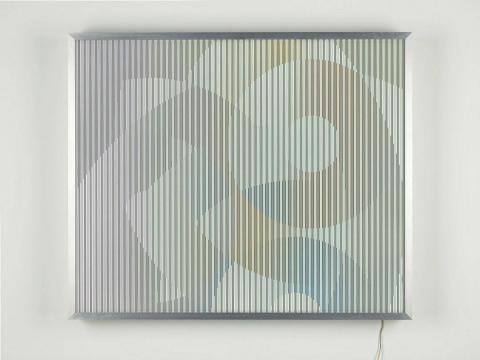AUSTIN, Lincoln; Out of sight
By Peter McKay
Lincoln Austin is a Queensland-based artist renowned for his exacting geometric sculptures. Created from wire and metal mesh, and descriptive of mathematical series, these works produce perplexing optical illusions and moire effects. Recently, Austin has started experimenting with other materials to similar ends. Maintaining his interest in puzzles and patterns, he seeks new ways to imply three-dimensional space in a two-dimensional picture format.
Using something akin to lenticular technology, these works become animated as the viewer moves past them or changes position, revealing a ‘hidden’ sequence of images. In this way, the viewer controls the tempo of the composition and, to this extent, some of the work’s affect. The experience is further heightened by a series of LEDs in the interior, which produce a machine-like glow. Recently acquired by the Gallery, Austin’s Out of sight 2013 exemplifies this bold new strategy. Watching and interacting with the swirling abstract Out of sight is an entrancing experience. Activating its secrets and peering into its potential is a playful activity: it could even be said that the audience is simultaneously performing and viewing.
A cool aluminium finish and bold graphics give a retro appearance: think space-age clean, rounded, modernist metallic forms, inhabiting op-art incisions. In this curious way, Out of sight is making an understated formal reference to the early-twentieth-century art movement Orphism, and in particular, the work of its key proponents Robert Delaunay (1885–1941) and Sonia Delaunay (1885–1979)(1).The Orphists — taking their name from the fabled musician and poet in ancient Greek mythology, Orpheus — sought to infuse the cubist methods of abstraction with bright colours, which made for stimulating fields of vision. They patterned their colours in a mode analogous to the way that music patterns sound: art as music for the eye. In Out of sight, the skill and precision with which Austin constructs his work is key — he has let these circular forms repeat seamlessly, like a melody. Its reflective surface enables the work to ‘play in tune’ with the colour of its surrounds.
Austin has a particular interest in music. Appropriately, the titles from this latest series of works are borrowed from popular music important to the artist. ‘Out of sight’, for example, is the title of a 1964 song by James Brown. Austin commented:
Brown was notorious for using the double entendre in his lyrics, usually referring to sex. This song was one that set the stage for the development of funk, which influenced the psychedelic soul and disco that followed. The title also refers to the fact that, at any one time, 80 per cent of the 'image' is literally out of sight as it is obscured by the pattern of the front panel. I enjoyed the perversity of calling a work that is, in some respects, overflowing with image, ‘Out of sight’.(2)
And while Out of sight is abstract - comprised primarily of circles in two sizes - the smaller circles, drawn out with thick perimeters, look something like a pupil and iris. As they materialise and vanish, the larger circles around them appear and then intersect one another, forming the almond shapes of an eye. Whatever importance you might give this subtle iconography, this elliptical ‘opus’ conveys an emotive and thoughtful groove on the pleasure of seeing.
Peter McKay, Artlines no.2, 2014, p.39.
1 Sonia Delaunay is represented in the Collection by two works: a print, Untitled c.1970; and a weaving, Tapestry: Syncopée c.1973–74.
2 Lincoln Austin, email to the author, 19 March 2014.
Connected objects

Out of sight 2013
- AUSTIN, Lincoln - Creator